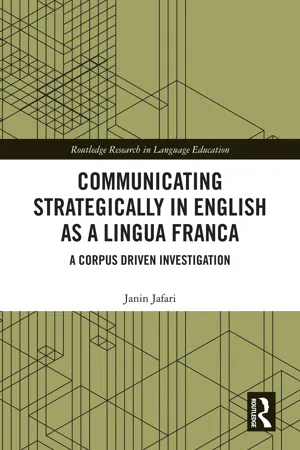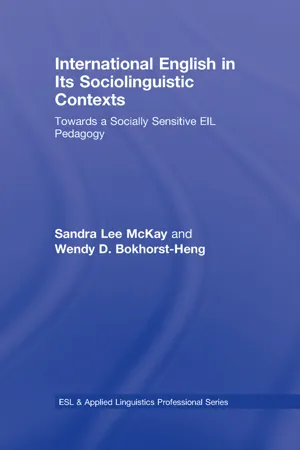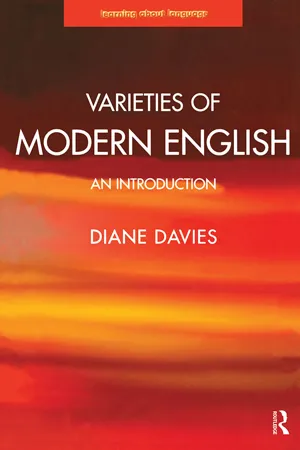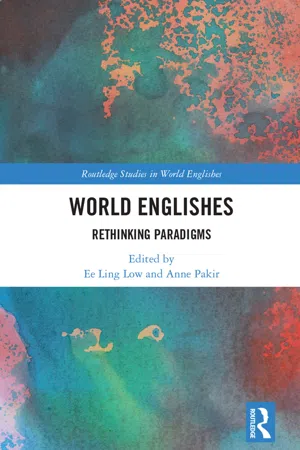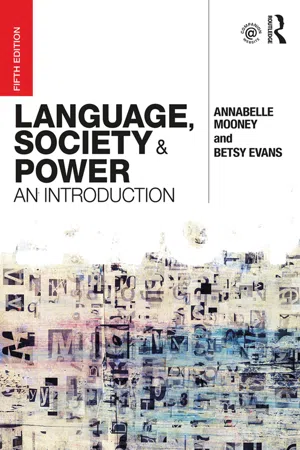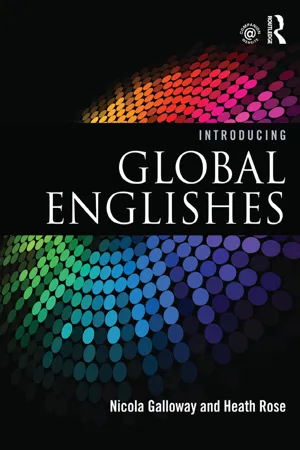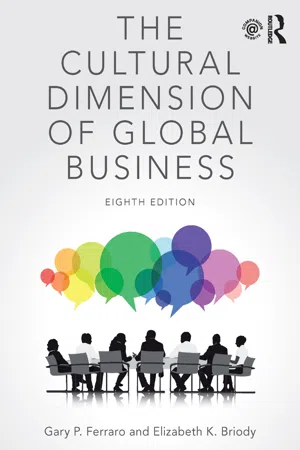International English
International English refers to the use of the English language as a global lingua franca, with variations in vocabulary, pronunciation, and grammar influenced by different cultures and regions. It encompasses the diverse ways English is spoken and written around the world, reflecting the language's adaptability and evolution in response to international communication and interaction.
8 Key excerpts on "International English"
- eBook - ePub
Communicating Strategically in English as a Lingua Franca
A Corpus Driven Investigation
- Janin Jafari(Author)
- 2020(Publication Date)
- Routledge(Publisher)
...1 The spread of English in a global world 1.1. English as an International Language The rapid growth of English has increased the number of speakers from various backgrounds, and the English of these speakers takes a variety of forms. English now plays a crucial role in “contexts where people from diverse linguistic, cultural and national background interact and communicate with each other” (Matsuda, 2012, p. 2). Economic, cultural and educational contexts have determined English’s status as an international language. Sharifian (2009, p. 2) conceptualizes English as an international language (EIL) as a “paradigm for thinking, research and practice” and emphasizes that the discipline of EIL does not refer to a specific variety of English, adding that “English, with its many varieties, is a language of international, and therefore intercultural, communication”. Smith (1976, p. vi) indicates that EIL is “the use of English by people of different nations and different cultures in order to communicate with one another”. Hence, “English is not one of our national languages, but it is our international language. And English as an international language is not the same as English as a second or foreign language” (Smith, 1983, p. 7). Considering this fact, both native and non-native English speakers need to be trained in order to communicate with each other effectively in an EIL context. Although Kachru (1986, 1992) conceptualized World Englishes (WEs) as three concentric circles that describe the distribution of English around the world, many scholars (e.g., Canagarajah, 2006a; Graddol, 1997; Jenkins, 2006a; Pennycook, 2003; Seidlhofer, 2004; Sharifian, 2009) have argued that this model does not include English use in a multilingual context. According to Bolton (2004, p...
- eBook - ePub
Reconceptualizing English for International Business Contexts
A BELF Approach and its Educational Implications
- Elma Dedović-Atilla, Vildana Dubravac(Authors)
- 2022(Publication Date)
- Multilingual Matters(Publisher)
...However, the elusive and altering character of its usage, the elusive nature of its functions, the various channels and modes through which it has established itself in different regions of the world have given birth to very complex theoretical considerations regarding English as an international language. Thus, a wide array of different concepts and terms related to its global status has stemmed from different viewpoints and given a path to the rise of divergent linguistic factions regarding the issue. Several terms are used to refer to English in its international usage role. Thus, in the literature tackling this issue, we might encounter expressions that have similar and sometimes almost identical meanings. Addressing English as it is variously used across the world, linguists write about World English (WE), World Englishes, New Englishes, Global English, International English, Globish, English as an international language and English as a lingua franca (ELF) (e.g. Brutt-Griffler, 2002; Crystal, 2003; Gnutzmann, 1999; Mair, 2003; McArthur, 1998). Out of these, this book emphasizes two highly prominent and popular terms and concepts to describe the spread and precedence of English, World Englishes and English as a lingua franca, as these are the two relevant constructs in close relation to the topic of this book (the former is utilized as a reference point in a number of English as the business lingua franca [BELF] writings, while the latter is BELF’s conceptual kin). Although there is some overlap in the usage of the terms, over time these expressions have come to denote two separate concepts in linguistics and are categorized into two distinct research fields. World Englishes The concept of World English, later gradually altered to World Englishes/New Englishes/indigenized/nativized varieties, was coined by Braj Kachru who initially developed the Three Circle Model of World Englishes in 1985...
- eBook - ePub
International English in Its Sociolinguistic Contexts
Towards a Socially Sensitive EIL Pedagogy
- Sandra Lee McKay, Wendy D. Bokhorst-Heng(Authors)
- 2017(Publication Date)
- Routledge(Publisher)
...Chapter 5 Linguistic variation and standards Thus far, our discussion has focused on the social factors involved in the teaching and learning of EIL. This chapter takes a much more micro-level approach, focusing on the linguistic diversity of present-day English use. Special attention will be given here to the development of World Englishes, their features and relationship to identity issues, particularly focusing on the plurality of World Englishes in their contexts of socio-cultural diversity. We will argue that language contact necessarily leads to linguistic variation and that such variation is clearly related to issues of power. This discussion of linguistic variation will be followed by a thorough analysis of the question of standards in EIL pedagogy. Various meanings of intelligibility will be discussed, as well as criteria for determining when a linguistic innovation should be considered as a norm. We will argue that EIL pedagogy should encourage awareness of the variation that exists in English today and recognize the validity of different varieties of English. Interpreting language variation As was noted earlier, the current growth of English is due largely to the increasing number of second language speakers of English who are learning English within their own country. Brutt-Griffler (2002) terms this process of second language acquisition by speech communities in their own local context macroacquisition. The large-scale macroacquisition that is occurring today has resulted in many speakers of English using English in contact with their other languages, sometimes on a regular basis. One result of such contact is a type of linguistic hybridization that we referred to earlier in advertising, music, movies and electronic communication. In addition, in contexts where English is used on a daily basis among bilinguals, the changes in English that are developing are being codified and accepted as standard...
- eBook - ePub
Varieties of Modern English
An Introduction
- Diane Davies(Author)
- 2014(Publication Date)
- Routledge(Publisher)
...It is also sustained by the fact that large numbers of people across the world need to learn EIL, even if they already speak a local variety of English and one or more other languages, like the two Malaysian lawyers above. Brutt-Griffler (2002) has argued that the development of a global language has four ‘central features’: first, its ‘econocultural functions’ as a product of a world market and of global science, technology, culture and media; second, its ‘stabilization of bilingualism’ through the fact that it coexists with local languages in bilingual/multilingual contexts; third, its ‘transcendence of the role of an elite lingua franca’ (since a global language is learnt by various socio-economic groups, not just an elite); and fourth, the fact that it spreads because many people in a speech community learn it and not because speakers of English migrate to other areas. In this chapter we will look in more detail at English as an international language, at some of the results of work done to describe it, and at some of the implications (for both spoken and written English) of using new corpora of English as a lingua franca to inform ELT provision. We will also consider whether the future of EIL could be impeded or threatened on the basis of current events and attitudes. 10.2 (Spoken) English as an international language Crystal (1999) anticipates the emergence of what he terms a World Standard Spoken English (WSSE), which he describes as a ‘regionally neutral international spoken standard, acting as a stabilising force on global spoken diversity’ (reprinted in Burns and Coffin, 2001:58). Crystal argues that this will be used for international communication in a multi-dialectal world in which many users of English will have three dialects at their disposal, two of them having ‘status as educated standards’...
- eBook - ePub
World Englishes
Rethinking Paradigms
- Ee Ling Low, Anne Pakir, Ee Ling Low, Anne Pakir(Authors)
- 2017(Publication Date)
- Routledge(Publisher)
...5 Teaching English as an international language A WE-informed paradigm for English language teaching Aya Matsuda and Paul Kei Matsuda 5.1 Introduction One word that describes the sociolinguistic landscape of the English language today is “messy.” The geographical spread of English has resulted in the emergence of new varieties of English – or Englishes – that reflect and serve the communicative needs of local users more effectively than dominant forms of English. The spread also has resulted in broader and more complicated definitions of the English speaker and the English-speaking culture. English speakers today are quite heterogeneous and diverse; they come from diverse linguistic, cultural and educational backgrounds. They have learned English in different ways and for different purposes from traditional English users. The cultural assumptions and frames of reference they bring to the table are equally diverse and often unpredictable. Their own variety of English may be the only language they know or it may be part of their larger linguistic repertoire. They may live in English-dominant contexts or contexts where English co-exists with other languages. Or they may transcend various communities where English may be used differently and to varying degrees. World Englishes (WE) has been one of the earliest and most influential intellectual traditions to systematically investigate the messiness of the English language, exploring the diversity of Englishes in terms of the structure as well as its users and uses. Over the years, WE studies have amassed a substantial body of knowledge in various aspects of the spread and diversification of Englishes...
- eBook - ePub
Language, Society and Power
An Introduction
- Annabelle Mooney, Betsy Evans(Authors)
- 2018(Publication Date)
- Routledge(Publisher)
...Examples of UK, Singlish and Indian English are presented to illustrate differences that exist among them. We then explore how different varieties of English play a role in social capital in the global linguistic marketplace, and perspectives on the position of English as a global language as active linguistic imperialism are presented. Finally, we consider variation and subjectivity in the meaning of English by considering English as it is used in linguistic landscapes around the world. 10.2 What Does Global English Mean? In the first chapter of this book, we examined the question ‘What is language?’ To that end, we considered how language is a structured system that speakers inherently understand and learn along with linguistic and communicative competence. We also raised the topic of politics and power in relation to how languages are defined. That is, whether a variety counts as ‘language’ rather than simply a variety of another language is more a question of power and other ideologies than it is a question of linguistic structure or fact. These are key issues to keep in mind as we consider global Englishes. In order to understand what global Englishes means, we begin with Kachru’s model of ‘World Englishes’ (1985), which considers the different kinds of English around the world and provides a visual representation of these varieties that can be interpreted in different ways. Figure 10.1 Kachru’s Circles of English (1985) The concentric circles in Figure 10.1 outline the distinction that Kachru makes between inner, outer and expanding circle nations in the World Englishes context. Inner circle nations are countries where English is spoken as a first language (‘mother tongue’ or L1). They are very often nations to which very large numbers of people migrated from the UK. For example, the US and Australia are inner circle nations...
- eBook - ePub
- Nicola Galloway, Heath Rose(Authors)
- 2015(Publication Date)
- Routledge(Publisher)
...A number of definitions have been posited for ELF in previous publications. Smith discussed EIL as early as 1976, and various other terms have been used to describe the use of English among people from different first-language backgrounds, including: • World English (Brutt-Griffler, 2002); • English as a global language (Crystal, 2003; Gnutzmann, 1999); • English as a world language (Mair, 2003); • International English (McKay, 2002); • Global English (Crystal, 1997); • English as a medium of intercultural communication (Meierkord, 1996). The large number of terms can cause confusion, and there is also a danger that the multiplicity of terms may cloud some of the important issues and compromise the advancement of research within the field of ELF, and Global Englishes in general. As pointed out in the Preface, this is particularly the case with EIL. Sharifian (2009, p. 6) notes that ELF is a theme ‘that can broadly be associated with the EIL paradigm’, while also noting that ‘the ELF movement has only focused on the linguistic code and has failed to engage with the political/ideological dimensions of native/non-native distinction’. Criticisms of the ELF paradigm, and responses to these criticisms, are addressed in Section 7d, but here it is important to point out that, while a lot of ELF research does focus on the linguistic study of ELF communication and the underlying motivations that give rise to certain innovations in the use of the language, ELF research is very much concerned with the political/ideological dimensions of the global spread of English. In a more recent publication on EIL, Alsagoff (2012b, p. 111) states that, A distinguishing feature that characterizes English as a world language is the fact that it is used for communication across linguistic and cultural boundaries...
- eBook - ePub
- Gary P. Ferraro, Elizabeth K. Briody(Authors)
- 2017(Publication Date)
- Routledge(Publisher)
...Tom McArthur (2005: 58) developed a way to represent the languages of the world both in terms of their “size and ‘clout,’” referring to it as the “seven-level model.” English, in its “many varieties,” is the only language identified with level 1. He continues, “It can be heard or read almost everywhere, and is the world’s primary vehicle for the media, commerce, technology, science, medicine, education, popular and youth culture, travel, trade in armaments, and United Nations peace-keeping.” Data from Ulrich Ammon at the University of Düsseldorf in Germany suggest that the number of English speakers is far greater than Table 4.1 indicates. His tabulations of English speakers total 527,000,000 and include both first- and second-language native speakers. However, even Ammon’s estimate is likely much lower than the total number of people conversant in English worldwide. Being “conversant” represents a far lower bar than being a “second-language native speaker.” Numerous factors that have encouraged some level of English-language acquisition including multinational or global firms, the media, the entertainment industry, the growth of the Internet, and the dissemination of scientific work (largely in English), to name a few. Many firms have adopted English as their primary business language such as major global airlines, manufacturing firms, and technology firms. Many university professors around the world teach in English—such as M. Sunwoo at Hangyang University in Seoul, Korea—thereby requiring their students to improve their English-language skills. How should native English-speaking businesspeople respond to the rise in English language use around the world? In some ways it is terrific! Knowing that English is spoken in the offices of a global firm can provide a certain level of comfort for the newly arrived, particularly if they are monolinguals...
